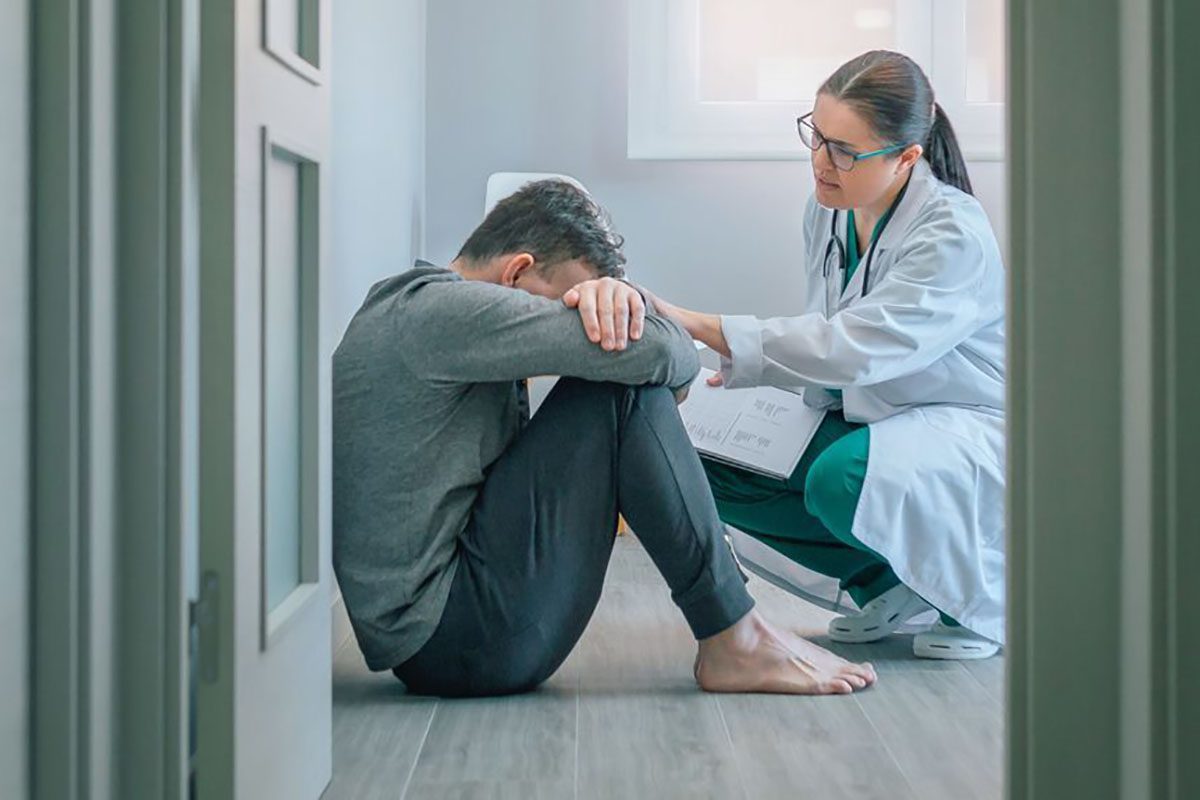
COVID-19, Mental Health, and Suicide Risk Among Health Care Workers:
Looking Beyond the Crisis
Coronavirus disease 2019 (COVID-19) led to unprecedented health care challenges. While it is essential to consider the impact of this crisis on patient care, it is also critical to consider the long-term impact on health care workers (HCWs). Medical personnel are on the frontlines—risking their welfare while society at large undertakes unprecedented social distancing. This disparity has inspired the public to describe medical professionals in heroic terms. While the media recognizes HCWs’ tremendous stressors (eg, risky public service, shortages of medical resources, peer illness/death), the potential for more serious mental health crises among HCWs has not received enough attention.
The medical profession is held in high esteem, which may help explain why HCWs’ mental health needs are often underrecognized. Alarming rates of mental health concerns such as posttraumatic stress disorder (PTSD) have been reported among HCWs involved in trauma care.1 HCWs are at increased risk for suicide compared to other occupational groups and the general public.2,3 Working cohorts usually show lower mortality rates than the general population since workers have lower rates of severe medical or psychiatric conditions and better access to health care (often called the “healthy worker effect”). Thus, it is notable that the suicide rate for physicians is 44% higher than population rates. Nurses and other HCWs also experience elevated risk.4
Given the baseline risk for mental health problems among HCWs, the unique challenges of the COVID-19 crisis and its long-term consequences heighten concerns. Work conditions on the front lines, fears regarding personal and familial health, and concerns for job security in light of HCW furloughs may amplify preexisting psychiatric conditions. During the early stages of the COVID-19 crisis in China, 72% of HCWs reported general distress, about half reported depression and/or anxiety, and 34% reported insomnia; those with direct COVID-19 exposure reported the highest distress.5 HCWs who experience psychiatric concerns may experience barriers to mental health care due to structural (eg, increased workload, childcare) and socio-emotional factors (eg, stigma).
The mental health needs of HCWs, including burnout, depression, PTSD, and, in particular, suicide risk, should not be ignored. A leading theory of suicide states that individuals who feel isolated and view themselves as a burden to others (particularly when these states are perceived as intractable) are more likely to experience suicidal ideation.6 Exposure to death, pain, or provocative experiences also increases risk for suicide by normalizing pain and decreasing fear of death.6 On the frontlines of this pandemic, HCWs are placed in an impossible bind—a choice between calling out sick for potentially inconsequential symptoms and continuing to serve, risking transmission. Although the protective effect of comradery among coworkers should not be ignored, HCWs’ physical isolation to reduce risk to their families may heighten loneliness. These experiences, in addition to resulting furloughs for HCWs in the aftermath of the immediate crisis, can increase feelings that one is a burden, and suicide risk factors related to isolation deserve special attention.
Some HCWs are experiencing high rates of vicarious medical trauma, a risk factor for PTSD. Messaging via social media (#GetMePPE) and pleas for donations of medical supplies underscore the challenges that HCWs face when making life-and-death decisions regarding allocation of necessary resources. Once the immediate crisis subsides, the impacts of exposure to death and experiences that violate personal values, beliefs, or morals (ie, moral injury) should not be underestimated, as the potential for depression and PTSD among some HCWs appears high.
During an emergency it can be difficult to look past the immediate crisis, but we urge the field to attend to HCWs’ mental health needs now and going forward given the long-lasting implications of the pandemic. Suicide prevention research emphasizes building meaningful social connections and interventions to decrease perceived burdensomeness. Given the potential for moral injury related to ventilator allocation, shared decision-making and provision of psychological support are recommended. Systems should also facilitate access to mental health care, particularly for HCWs with preexisting psychiatric conditions.
Interventions that address HCW mental health needs are available. Systematic reviews indicate that interventions can reduce burnout and emotional exhaustion.7 Specific hospital strategies for supporting HCWs during the COVID-19 crisis are emerging in the literature. HCWs in China emphasized the benefits of uninterrupted sleep.8 Shifts that include breaks from direct COVID-19 patient care may mitigate burnout. Since many HCWs have access to lethal suicide means, means safety represents an important suicide prevention strategy for at-risk HCWs. Disaster psychiatry and psychological first aid could be considered broadly. Finally, tele-mental health can facilitate safe access to services during the crisis, resulting in a more sustainable workforce.
HCWs are currently described in heroic terms; however, HCWs are not “superhuman.” The ongoing pandemic-related stressors are expected to increase mental health concerns, including suicidality,9 among some HCWs. Many HCWs may experience a fear of stigma when considering mental health care. These servants deserve our full support, and we owe it to them to deliver these resources in a non-stigmatizing, accessible, and sustainable format for the duration of this crisis and, potentially, beyond.
Received: April 2, 2020.
Published online: August 4, 2020.
Potential conflicts of interest: None.
Funding/support: None.
Disclaimer: The views expressed in this article are those of the authors and do not necessarily reflect the position or policy of the Department of Veterans Affairs, University of Washington, or Washington University in St. Louis.
REFERENCES
1.Luftman K, Aydelotte J, Rix K, et al. PTSD in those who care for the injured. Injury. 2017;48(2):293-296. PubMed CrossRef
2.Hawton K, Agerbo E, Simkin S, et al. Risk of suicide in medical and related occupational groups: a national study based on Danish case population-based registers. J Affect Disord. 2011;134(1-3):320-326. PubMed CrossRef
3.Dutheil F, Aubert C, Pereira B, et al. Suicide among physicians and health-care workers: a systematic review and meta-analysis. PLoS One. 2019;14(12):e0226361. PubMed CrossRef
4.Hawton K, Simkin S, Rue J, et al. Suicide in female nurses in England and Wales. Psychol Med. 2002;32(2):239-250. PubMed CrossRef
5.Lai J, Ma S, Wang Y, et al. Factors associated with mental health outcomes among health care workers exposed to coronavirus disease 2019. JAMA Netw Open. 2020;3(3):e203976. PubMed CrossRef
6.Chu C, Buchman-Schmitt JM, Stanley IH, et al. The interpersonal theory of suicide: a systematic review and meta-analysis of a decade of cross-national research. Psychol Bull. 2017;143(12):1313-1345. PubMed CrossRef
7.West CP, Dyrbye LN, Erwin PJ, et al. Interventions to prevent and reduce physician burnout: a systematic review and meta-analysis. Lancet. 2016;388(10057):2272-2281. PubMed CrossRef
8.Chen Q, Liang M, Li Y, et al. Mental health care for medical staff in China during the COVID-19 outbreak. Lancet Psychiatry. 2020;7(4):e15-e16. PubMed CrossRef
9.Reger MA, Stanley IH, Joiner TE. Suicide mortality and coronavirus disease 2019: a perfect storm? [published online ahead of print April 10, 2020] JAMA Psychiatry. PubMed
aVA Puget Sound Health Care System, Seattle, Washington
bDepartment of Psychiatry and Behavioral Sciences, University of Washington, Seattle, Washington
cDepartment of Psychological and Brain Sciences, Washington University in St Louis, St Louis, Missouri
*Corresponding author: Mark A. Reger, PhD, 1660 South Columbian Way (S-116), Seattle, WA 98108-1532 (mark.reger@va.gov).
J Clin Psychiatry 2020;81(5):20com13381
To cite: Reger MA, Piccirillo ML, Buchman-Schmitt JM. COVID-19, mental health, and suicide risk among health care workers: looking beyond the crisis. J Clin Psychiatry. 2020;81(5):20com13381.
To share: https://doi.org/10.4088/JCP.20com13381
© Copyright 2020 Physicians Postgraduate Press, Inc.
This PDF is free for all visitors!



